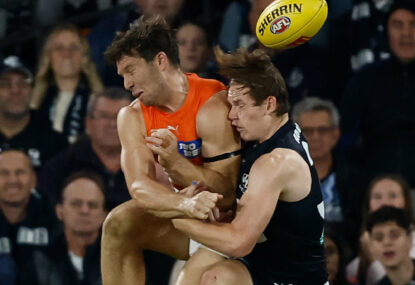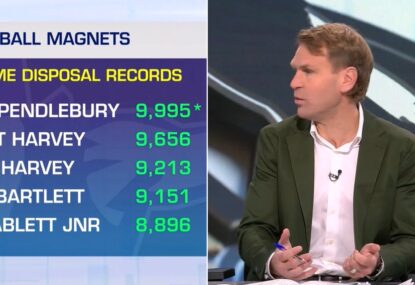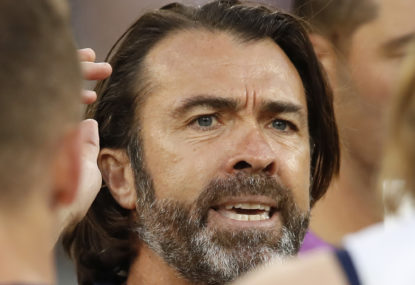So what did Friday night tell us about Collingwood?
It was a fair hit-out full of genuine intensity against the premiers. Jordan De Goey was great in the middle and Isaac Quaynor was lively coming out of defence. Scott Pendlebury showed he’s still integral to Collingwood’s midfield.
If there were queries about whether Nathan Buckley still had the playing group after the 2020 trade debacle, or if the exit of so many players had fractured team morale, they played with the same ferocity that they’ve always exhibited under Buckley.
So all that was great. But Collingwood need more than this.
This season, Collingwood fans are hoping for something improbable. They’re hoping for something different.
Because ten years into the current on-field administration, of watching the same mistakes repeated, of being frustrated by the same issues, we appreciate the need for change, improvement and evolution.
There’ll be fans who champion that’s already going on.
We’re told to trust Nathan Buckley and company. Why? Based on what? That the tenth year is a charm? We’re told it’s about to click. Really? How many times have Collingwood threatened that in the last decade? We’re told this player and that player coming up will be the difference, but these are inexperienced players who are expected to input immediate quality and consistency.
Is that a realistic expectation from so many?
While Friday night was only Collingwood’s second practice game for the season, and while we have to consider that it was against the AFL premiers and there’s a whole season to improve, a lot of what we saw was worrying.
Here’s ten things that concerned me.
10. Playing on quickly isn’t the same as playing fast and direct
A lot has been made of Collingwood changing the way they’re going to play. Nathan Buckley talked about it pre-game.
And what did we get?
Well, initially, players would mark and pass immediately. This led to a lot of turnovers. When Richmond applied the pressure, this option disappeared.
This was the only notable difference.
Playing on quickly doesn’t amount to revolutionising the game plan. It’s just a tweak that’s trying to make something happen. In fact, it just made the side look desperate – as in desperate without legitimate options to consider.
9. Oliver Henry and company
Lots has been made of Collingwood’s draft haul. People have asked whether these young guns can have the same impact on Collingwood that Port Adelaide’s young guns had on Port’s fortunes.
Port finished minor premiers last year and got within a kick of a grand final.
Everybody lauds the importance of youth rejuvenating a stagnant playing list.
Connor Rozee’s name is bandied about – who’ll be Collingwood’s Connor Rozee?
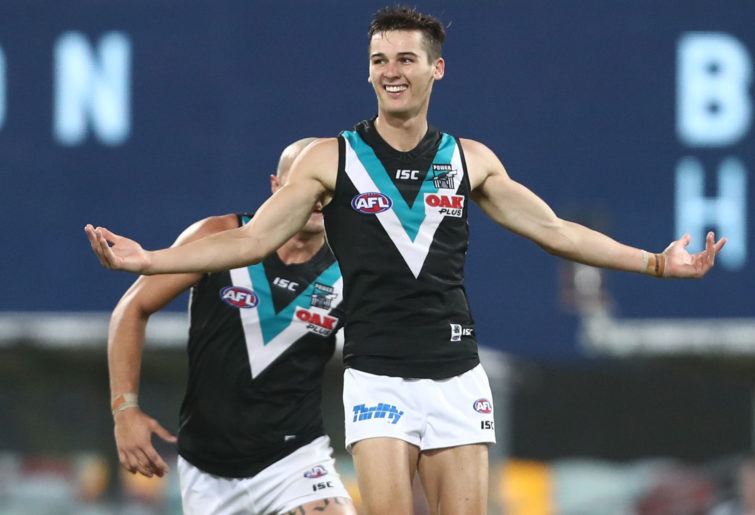
(Photo by Chris Hyde/Getty Images)
Hang on.
Rozee played 22 games in 2019. Xavier Duursma played twenty games in 2019. Port finished tenth in 2019.
These guys didn’t just waltz up into 2020 and spearhead a charge up the ladder to become minor premiers. They had gotten full season of development into them – a full season in which Port missed the finals.
Oliver Henry is a likely prospect, but he showed on Friday night that it’s difficult for a young player to impact a contest in a side lacking structure and direction.
8. Handball madness
Collingwood love to try extricate themselves from congestion with snappy handballs, yet they continue to sacrifice players who are surrounded and have no recourse. Repeatedly on Friday, the ball was handballed to somebody who was crunched.
Otherwise, they again handballed back, back and back again, trying to find space, but only getting themselves into more trouble.
Another issue with the handballs – and which has existed for a long time – is that players seem intent on firing them at high velocity, rather than weighting them to their target. At times, the player on the receiving end fumbled because the ball came at them with such speed.
7. Why does Darcy Moore kick out?
Darcy Moore is 203 cm tall. He surely should be the on the end of kickouts as a tall marking target. It’s the logical thing to do.
Yet he’s kicking out.
It’s the simplest of tactical adjustments, but not something that Collingwood seems to have considered – ever.

(Photo by Michael Willson/AFL Media/Getty Images)
Moore has kicked out the last two seasons, and it would appear that’s going to be the same this year. This is just a basic thing. How is it overlooked?
6. Brayden Sier, Will Hoskin-Elliott, Josh Thomas and company
These are players whose careers would be riding on their performances this year.
Sier had some important late touches but looked ambivalent for much of the game. Given his height and size, you’d want him to impact contests the way Patrick Cripps does. You’d want smaller opposition midfielders second-guessing a contest fearing Sier’s physicality.
Josh Thomas did a few things, but Collingwood would expect much more from him. He’s now of an age and experience where doing a few things is no longer an acceptable return. He was great in 2018 but has struggled since. Same with Hoskin-Elliott.
Given the amount of inexperienced youth on Collingwood’s list, they need these players to stand up and provide solidarity through the core.
Without it, the side – as a whole – is going to rely on too few, and will struggle.
5. Where is the mongrel?
We saw Mason Cox get involved in several pushing altercations with Richmond players. Jack Riewoldt ran all the way from full-forward to Richmond’s centre-half back position to push, shove and banter with Cox.
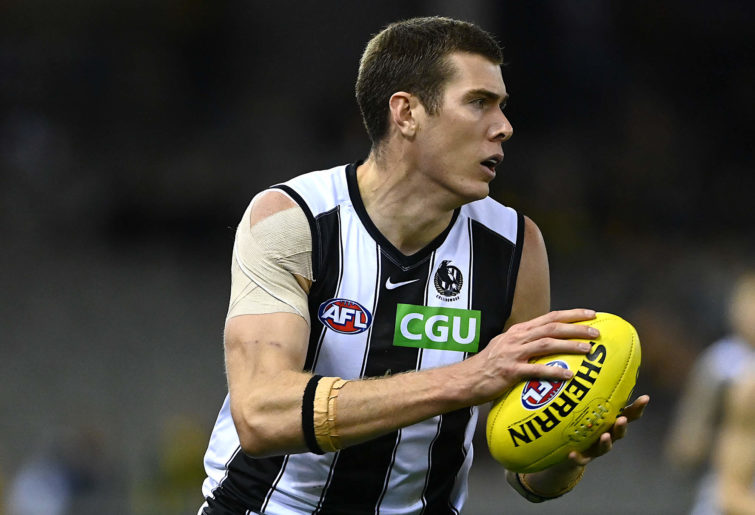
(Photo by Quinn Rooney/Getty Images)
Collingwood’s response?
Meh.
It’s a little thing, but you would want to see Cox’s teammates fly the flag here and show that they’re not going to get bullied. I’m sure if Taylor Adams had played he’d have been straight in there, but everybody else remained passive.
Before their rise up the ladder, you would’ve hardly considered Richmond a physical side, but you can see now how they all have each other’s backs now. They hunt as a pack, they defend as a pack.
It’s a sign of camaraderie and unity, and a group mentality that has the potential to bully the opposition before a ball is kicked in anger. All the great sides have had it – both Hawthorn and Brisbane exhibited this attitude during their respective three-peats.
I’m not expecting thuggery, but football is a team game. You want to fear the unit and part of doing that is seeing how they stand up for one another.
Where’s that at the Pies?
4. Cox looks much more dangerous when he’s leading out of the square
I’ve written about this for years. I’ve heard other supporters demand this. Even Garry Lyon mentioned it repeatedly during his commentary.
Later in the game when Collingwood started to get the ball in quickly, Mason Cox and Darcy Cameron looked dangerous.

(Photo by Adam Trafford/AFL Media/Getty Images)
But, otherwise, Collingwood allowed them to get sucked up the ground or moved the ball slowly to them. These are complaints that are now being chorused from all quarters.
Cox and Cameron are tall players. Their strength is going to be in the air. Yet Collingwood use them like flankers.
3. While Collingwood’s defence was lauded, Richmond were wasteful
Commentary lauded Collingwood’s defence for withstanding the Tiger onslaught, but the truth is that Richmond were wasteful. Richmond kicked 4.3 in the first quarter and 2.5 in the second. Had they been accurate, the game could’ve been as good and done by halftime.
That’s not to say Collingwood’s defence wasn’t good. But you do need to apply some context to the way the game unfolded.
Collingwood cannot rely on their defence to keep them in contests. They can only do and withstand so much before they buckle.
2. The lack of improvisation from the coaches’ box
Outside of Jordan De Goey playing in the middle – an evolution we’ve long expected – did Collingwood try anything new?
In the last two minutes of the game, when the match was there to be won, Darcy Moore found himself forward. He either wandered down there on his own or followed his opponent there as Richmond clogged up Collingwood’s F50.
It would’ve been nice to see Collingwood experiment. Why not play Darcy Moore at full-forward? Why not throw Isaac Quaynor in the middle? Hell, stick Brodie Grundy on the wing for a bit.
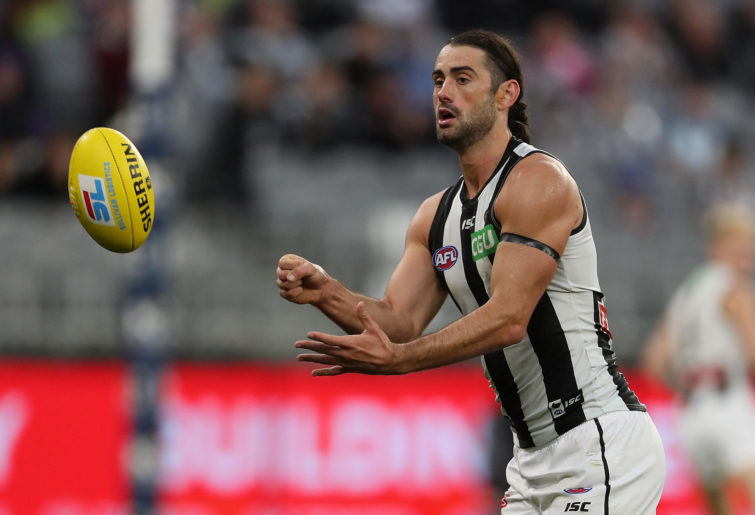
(Photo by Paul Kane/Getty Images)
Collingwood need to find new strengths within their playing list. They cannot just rely on organic improvement.
We know what these players can do in their default positions. While an argument might be made for knitting them together so they’re ready for the home-and-away season, these practice games surely should encourage the coaching staff to experiment.
1. There remains a lack of structure around the ball
When Richmond had the ball, they moved in waves, sweeping through Collingwood’s zones. Every time they had the ball in hand, you feared they would construct a scoring attempt.
When Collingwood had the ball, they tried to puzzle a way through. The few times they offered run, purpose and moved the ball directly was on the back of some player (usually Scott Pendlebury) taking an audacious course of action to penetrate Richmond’s defensiveness.
Lots of Collingwood’s issues are structural: the inability to keep Cox anchored to the goalsquare, the frustration of trying to manufacture that ruck-midfield synergy, the difficulty in trying to move the ball quickly and effectively, the inability to play directly, the breakdown of zones on the counter-attack, etc.
Watching last night, I was struck by a realisation: the simplest reality might be that Collingwood doesn’t know how to manufacture these things and keep them intact, which is why they so often appear amorphous, only finding shape sporadically to tease us before falling back into shapelessness.
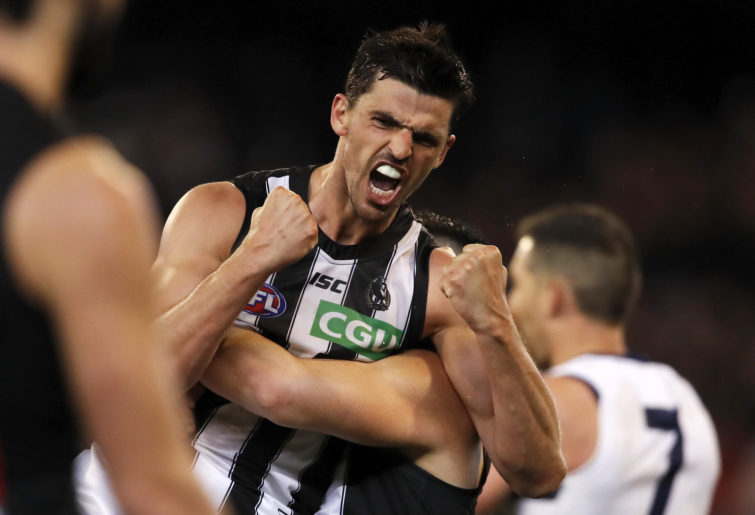
(Dylan Burns/AFL Photos via Getty Images)
When the side was young and inexperienced, you could argue they were still finding their way. But the coaching staff has been there ten years. The team has played in three consecutive finals campaigns.
Yet we’re still seeing them same structural dilution, the same unraveling, the same struggle to consistently mount purposeful offensives.
The only exception is 2018. How did they get it right? Was it a confluence of everything falling into place? Was it intel from assistants who are no longer there? Was it a standout season simply because so many players surprised, but have since been worked out?
The one reality we can be certain of is the evidence overwhelmingly suggest Collingwood struggle to consistently display and maintain genuine cohesion, and have done so over the last nine seasons.
It’s really worrying that 2021 might just offer more of the same.



































































































